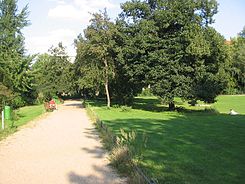Wartburgplatz (Berlin)
| Wartburgplatz | |
|---|---|
| Place in Berlin | |
 Wartburgplatz |
|
| Basic data | |
| place | Berlin |
| District | Schöneberg |
| Created | 1902 |
| Confluent streets |
Martin-Luther-Strasse , Wartburgstrasse, Apostel-Paulus-Strasse, Gothaer Strasse |
| Buildings | House of Youth |
| use | |
| User groups | Pedestrians , cyclists , road traffic , public transport |
| Space design | Paul Egeling |
The Wartburg Place is a small urban park in Berlin district of Schoeneberg the district Tempelhof-Schöneberg .
Location and history
The Wartburgplatz is bordered by the Wartburg-, Martin-Luther- , Apostel-Paulus- and Gothaer Straße and is located around 300 meters north of the Schöneberg town hall . On the other side of Apostel-Paulus-Straße to the north is the extensive building complex of the Schöneberg District Court . The square with a side length of around one hundred meters consists of a rectangular tree-lined meadow, which is surrounded by a path. It has a playground and on the square is the cultural center "Die Weisse Rose ", which was opened in 1956 by the district office as the " House of Youth ".
The design of the square comes from city planning officer Paul Egeling . The grand opening took place in 1902. The names Wartburgplatz and Wartburgstraße (after the Wartburg ) had already been established around 1899 . This refers to the adjacent Martin-Luther-Straße, as there are several other street names related to Luther's life . The square is in the middle of a densely built-up residential area with bourgeois apartment buildings, most of which date from before the First World War . The Bavarian Quarter with its representative Wilhelminian style development is in the immediate vicinity.
Until 1963, Wartburgplatz was the final stop on tram line 66 , which ran between Schöneberg and Steglitz . On May 2, 1963, the tram line was discontinued and switched to bus service.
playground
The playground on Wartburgplatz is very popular. Children and young people who attend performances in the adjacent theater can then let off steam here. Especially the high and nested corridors and bridges of the “knight's castle” exert a fascination on the players.
Works of art
Two horses with a carriage

On the playground is the approximately 1.20 meter high figure Two Horses with Carriages by the artist Hilde Richter, who produced various other works for playgrounds and won a prize for the design of Berlin clay playgrounds.
The crouching one
Another figure stands on the northern edge of the meadow. The sculpture Die Kauernde (or Die Hockende ) from 1956 is the work of the Berlin sculptor Katharina Szelinski-Singer , who became famous for her monument to the rubble women in Hasenheide Park . After the rubble woman, the crouching figure is the artist's second work in public space.
The 1.25 meter high sandstone figure represents a life-size female half-nude with a sideways turned head, kneeling in the grass. The right hand rests in the lap while the other hand presses the skirt to the left shin. In 2007 the work shows various damage. Part of the back of the head has broken off, so that an inner stabilizing iron is exposed at this point. The left eye is knocked out. In addition, the work has various smears that obviously cannot be completely removed.
A model for the free sculpture, a 22 centimeter high bronze figure, is in the artist's possession.
Web links
- Wartburgplatz. In: Street name lexicon of the Luisenstädtischer Bildungsverein (near Kaupert )
- Entry on Spielplatz.de
- Entry on Kindaling.de
Coordinates: 52 ° 29 ′ 15 ″ N , 13 ° 20 ′ 46.4 ″ E